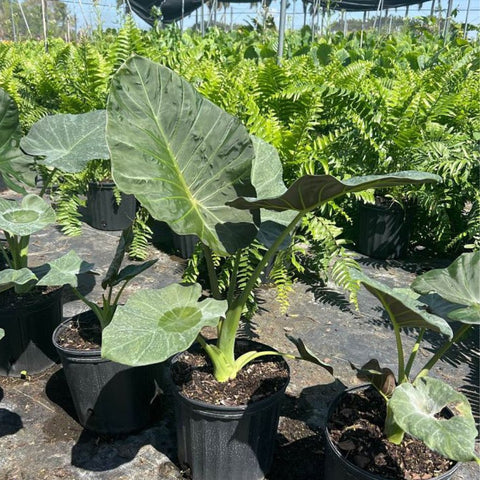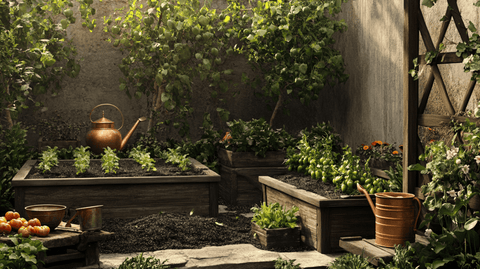Introduction
As winter's grip begins to loosen and the whisper of spring is felt in the gentle warmth of the sun, gardeners everywhere feel a stirring excitement. This is the season of renewal and potential, where the soil, chilly yet awakening, starts to throb with life once more. Early spring presents a unique opportunity for gardening enthusiasts to embark on planting endeavors that promise a bountiful harvest when summer fully unfurls. For both novices and seasoned green thumbs, understanding and mastering early spring planting can be the secret to a vibrant and flourishing garden.
The purpose of this guide is to delve into the concept of early spring planting, exploring its myriad benefits and providing actionable insights into how to get started. From choosing the right plants to mastering the timing, early spring planting sets the foundation for a thriving garden and maximizes seasonal yields.

Understanding Early Spring Planting
Definition and Importance
The concept of early spring planting revolves around the tactical early seeding and planting of specific plants that can withstand the lingering chill of winter. This strategy effectively extends the growing season, allowing enthusiasts to get a head start before the frenzy of late spring planting. Early spring planting not only ensures an earlier harvest but also allows for multiple harvests as the growing season progresses.
Benefits
Beyond the sheer thrill of starting early, numerous benefits are associated with this practice:
- Extended Harvest Period: Starting early means plants have more time to mature, often resulting in multiple harvests per season.
- Resilient Plant Growth: Many plants adapted for early spring are hardy, building resilience against pests and diseases.
- Maximized Yields: Engage in succession planting to ensure continual vegetative output as seasons change.
- Improved Soil Management: Early planting encourages earlier soil enrichment and amendment, which benefits all subsequent planting.
Preparing Your Garden for Early Spring Planting
Soil Assessment and Preparation
Before any planting can begin, assessing and preparing your soil is key. Consider these steps to ensure your garden is ready:
Testing Soil Quality
Conduct a soil test to analyze pH levels and nutrient content. Early spring is an ideal time to correct pH levels with lime or sulfur and add nutrients needed for optimal plant growth.

Soil Amendment
Aerating your soil will improve oxygen circulation, crucial for root development. Incorporate organic matter such as compost or well-rotted manure to enhance soil fertility.
Tools and Equipment
Equip yourself with the right tools for effective early spring preparation:
- Gardening Fork: Useful for turning soil and mixing in amendments.
- Rake: Essential for breaking up clumps and smoothing soil after tilling.
- Row Cover or Cold Frames: Provides protection for young plants from unexpected frosts.
Choosing the Right Early Spring Plants
Understanding which plants thrive in cooler temperatures is crucial for successful early spring planting. These plants are often more resilient to chilly conditions and can establish themselves before the heat of summer arrives.
Hardy Vegetables
Many vegetables are well-suited for early planting:
- Leafy Greens: Spinach, kale, and lettuce varieties can be sown directly into the soil.
- Root Vegetables: Carrots, beets, and radishes germinate well in cooler temperatures.
- Perennial Vegetables: Artichokes and asparagus, which are available as perennials for an extended harvest period.
Cold-Tolerant Flowers
Bring some early color to your garden with these robust flowers:
- Pansies and Violas: Known for their resilience and cheerfulness.
- Agapanthus: Known as Lily of the Nile, these can be introduced early for blooms that stand the test of transitional weather.

Starting from Seed versus Buying Plants
Both methods have their advantages in early spring planting:
- Starting from Seed: Offers variety and is often more economical. Perfect for gardeners who prefer a hands-on approach.
- Buying Plants: Jumpstarts the growing process. For a wide selection of robust plants ready for adoption, explore options at Plantology.
Mastering Early Spring Planting Techniques
Sowing Seeds
When sowing seeds early in the spring, timing and technique are everything. Opt for seed varieties that specify an early plant date. Additionally, pay close attention to regional last frost dates, with sowing occurring roughly four to six weeks prior to ensure germination.
Using Protective Measures
Cold Frame Utilization
These structures capture solar energy and provide insulation, safeguarding young sprouts from frost.
Cloches and Row Covers
Simply cover your plants to insulate them from unexpected cold snaps. They are crucial during the unpredictable weather that early spring often brings.
Watering Strategies
While watering needs are less during cooler months, consistency is key. Aim for deep watering, ensuring water penetrates to roots, pivotal for seed germination and early growth.

Integrating Ornamentals and Trees
Early Blooming Trees
Trees can provide structure and early visual interest in a garden:
Palm Trees
For a warm climate effect, consider integrating unique palm varieties. The Adonidia Palm comes in single, double, and triple trunk formats, allowing you to tailor your landscape to a tropical aesthetic.
Complementary Ornamentals
Incorporating evergreen and ornamental shrubbery provides year-round color while waiting for your flowers to bloom.
Ongoing Garden Maintenance
Monitoring Weather Conditions
Spring's unpredictable weather means gardeners need to remain vigilant. Keep an eye on forecasts to proactively protect plants from unseasonably cold temperatures.
Regular Inspection for Pests and Diseases
While early spring is less synonymous with pests, early detection is key to managing outbreaks before they affect your fledgling garden.
Conclusion
Early spring planting is a journey that offers both challenges and an endless supply of excitement and reward. With the right preparation and plant selection, you can transform your garden into a thriving ecosystem that delivers on its potential long before your neighbors have started their outdoor ventures. As you prepare to bring life to your garden, remember that Plantology is here to support you every step of the way with expert advice and a compelling array of plants ready to fulfill your gardening dreams. Don't hesitate to explore our diverse offerings, from elegant Agaves to majestic Alexander Palms.

Creating an Early Spring Planting Schedule
To ensure the success of early spring planting, it's crucial to develop and adhere to a detailed schedule. This structured approach not only helps avoid overlooking essential tasks but also allows you to track plant growth effectively.
Understanding Your Climate Zone
Your geographical area greatly determines the timing and selection of plants. Begin by identifying your USDA hardiness zone, as it provides insights into the average minimum temperatures of your region. This knowledge is critical for selecting plants that will thrive in your specific early spring conditions.
Organizing Planting Tasks
Break down tasks into a week-by-week checklist:
- Week 1: Conduct soil test and gather necessary amendments. Clean tools and inventory seeds and starter plants.
- Week 2: Amend soil as needed, prepare planting beds, and set up cold frames or row covers.
- Week 3: Sow seeds indoors, if applicable. Direct-seed cool-weather crops like peas, carrots, and kale.
- Week 4: Transplant hardy seedlings from indoor sessions outdoors. Prepare protection against late frosts.
Advanced Techniques for Early Spring Gardening
Beyond the basics, there are several advanced techniques that skilled gardeners can employ to maximize their early spring planting yields.
Succession Planting
This method involves staggered planting of crops so you can harvest continuously over the growing season. For instance, sow spinach and radish seeds every two weeks to ensure a steady supply.

Example: Start with fast-maturing crops such as radishes, then follow with succession rounds of lettuce or arugula, which can occupy the same space after the initial harvest.
Companion Planting
Integrate compatible plants to promote higher yields and reduce pests. Legumes such as peas can enhance the nitrogen content of the soil, benefiting companion plants like broccoli and cabbage.
Example: Plant onions and carrots together, as their scents can help ward off mutual pests like carrot flies and onion thrips.
Building Soil Health for Long-Term Success
Healthy soil lays the foundation for a successful garden and is particularly crucial in early spring when many plants are just establishing their root systems.
Encouraging Microbial Activity
Plants interact symbiotically with soil microbes. Applying a layer of organic mulch protects soil health and supports microbial communities, which in turn improves plant resilience and nutrient uptake.
Composting Techniques
Create a compost system in your garden to sustainably recycle plant waste, enhancing soil nutrition. Carefully balance green and brown materials to maximize decomposition efficiency.
Example: Add nitrogen-rich greens like vegetable scraps and grass clippings to browns like dried leaves and wood chips, maintaining moisture to keep your compost active.

Fine-Tuning Water Conservation in Early Spring
Spring's cool temperatures present an opportunity to conserve water while maintaining healthy plant development.
Drip Irrigation
Implementing a drip irrigation system allows for the precise delivery of water directly to the roots, reducing waste. This method is particularly effective in preventing disease spread that can occur with overhead watering.
Mulching
Apply a substantial mulch layer to retain soil moisture and suppress weeds. Organic options like straw or bark chips offer additional benefits by breaking down and enriching the soil over time.
Incorporating Wildlife and Pollinator-Friendly Features
To enhance biodiversity, attract natural pollinators, and promote healthy plant development, incorporate features that make your garden welcoming to wildlife.
Planting for Pollinators
Choose flowers that bloom early to support bees and butterflies who emerge in early spring:
- Hyacinths: Their vibrant colors attract multiple pollinator species.
- Hellebores: Known for their unique appearance and ample nectar supply during early spring.
Building Habitats
Provide a haven for beneficial insects and birds by offering nesting materials and creating sheltered spots in your garden. A simple birdhouse or insect hotel can make a significant difference.

Case Studies: Successful Early Spring Gardens
Understanding the real-world application of these techniques can solidify your approach and boost confidence as you embark on your own garden journey.
The Urban Green Space
In downtown Chicago, an urban gardener transformed a small balcony into a flourishing ecosystem using vertical garden techniques and cold-tolerant plants like swiss chard and violas. The integration of a drip irrigation system maximized space and efficiently managed water resources.
Community Garden Triumph
A community garden in Portland mounted a collaborative effort to engage residents in early spring planting projects. Groups established raised beds filled with early crops like rhubarb and cabbage, rotating duties for watering and pest control among members, thereby fostering local food security and camaraderie.
Reflecting on the Early Spring Planting Experience
The journey of early spring gardening doesn’t conclude with the planting itself. Instead, it extends into a season-long adventure as you nurture, adjust, and learn from every plot and plant.
Learning from Setbacks
Every experienced gardener knows that setbacks are inevitable. Unpredictable weather or plant disease can be frustrating, but they're also powerful learning opportunities. Evaluate what went wrong and research preventive measures to enhance future planting endeavors.

Celebrating Successes
As plants mature and the first harvests begin, take time to celebrate the results of your hard work. Share your bounty with friends and family, embrace the therapeutic rewards of gardening, and use your experience to plan for successful seasons to come.
Conclusion
Early spring gardening requires dedication and foresight but offers unmatched satisfaction. By understanding your environment, selecting the right plants, and employing innovative techniques, you can create a garden that not only thrives in the early months but continues to deliver throughout the year. Here at Plantology, we are committed to supporting your gardening journey with a range of superior-quality plants and expert advice. Visit our website today to explore our stunning collection of offerings, featuring everything from aromatic Thyme to robust Bougainvilleas, and let us be a part of your quest for a bountiful, beautiful garden.






























Comments (0)
There are no comments for this article. Be the first one to leave a message!